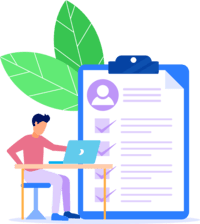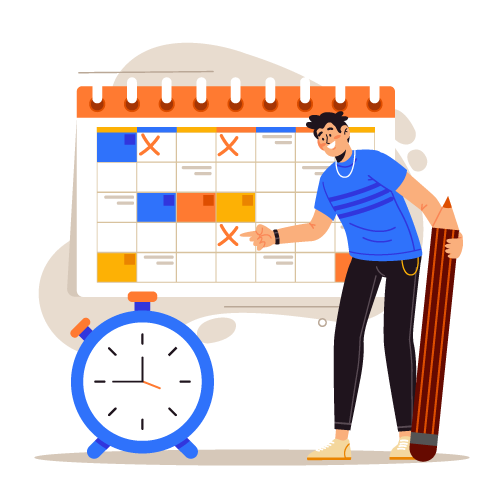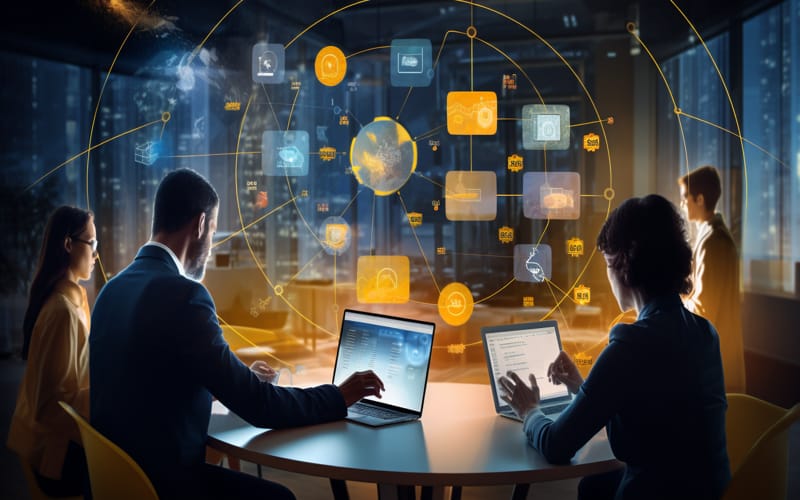SAP CRM Interview Questions
From technical to behavioural questions, our blog covers all elements of SAP CRM that will prepare you to ace any interview about it.
We have assembled a comprehensive list of frequently asked questions in SAP CRM interviews and detailed responses, offering solutions and suggestions for success.
So, let’s dive right in and ensure we ace SAP CRM interviews together!
 1. Can you explain what customer relationship management (CRM) is?
1. Can you explain what customer relationship management (CRM) is?
CRM is a business strategy that optimises customer interactions for business success.
It involves evaluating the customer’s relationship with the company and the company, followed by the service level, retention, and finally, the advocate stage.
2. Can you describe the different stages of the CRM process?
The different stages of the CRM process are the suspect, prospect, customer, and advocate stand.
The ultimate stage is the advocate stage, where the customer becomes a brand advocate and continues communicating with other customers.
3. What is the SAP CRM module?
The SAP CRM module is a new dimensional industry module focusing on customer and partner interactions.
It includes the main backend, ERP, which provides for distribution, materials management, human resource management, financials, corporate management, service, inventory, and production.
4. Can you explain the different marketing functions in the SAP CRM module?
Marketing in the SAP CRM module includes campaign management, customer segmentation, lean management, e-marketing, trade promotion management, marketing planning, and analytics.
5. Can you describe the different service management functions in the SAP CRM module?
Service management in the SAP CRM module handles service requests, service orders, contact administration, complaint and retained management, case management, installed base management, workflow and escalation management, and workforce management.
6. How does the SAP CRM business map streamline business processes?
The SAP CRM business map streamlines business processes by integrating all customers, suppliers, and business partners.
Major solutions include SAP, my CRM, analytics, marketing, e-commerce, sales solutions, interaction centres, services, field applications, and the SAP network.
7. Can you explain the SAP architecture?
The SAP architecture consists of a logical box that handles all customer interactions, including phone, email, and mobile client interactions.
The back-end systems include SAP, ECC, R3, BI Vivo, and SAP APO. The Advanced Planning and Optimizer handles the advanced sales process.
8. Can you explain the different layers of the SAP CRM database?
The SAP CRM database includes the database layer, application layer, index server, search engine, and J2EE communication.
9. Can you describe the different communication channels used in the SAP CRM system?
The communication channels used in the SAP CRM system include web channels, mobile clients, and handlers for sales representatives travelling in different areas.
10. How does the SAP CRM system connect to the SAP R3 or SAP ECC system?
The SAP CRM system connects to the SAP R3 or SAP ECC system through the adapter, a built-in component of the SAP CRM middleware.
11. What are the different applications included in the SAP CRM system?
The SAP CRM system includes applications like interaction centres, opportunity management, marketing planning, and campaign management.
12. Can you explain the role of the SAP CRM web client user interface?
The SAP CRM web client user interface is more user-friendly and can be customised for different organisational roles.
Customers can customise their views, icons, and user interface skin.
13. What are the SAP CRM web client user interface restrictions?
The SAP CRM web client user interface is restricted to administrators, and the end-user can only personalise system settings from the web client.
14. Can you explain the different main components of the SAP CRM system?
The SAP CRM system comprises several main components: the SAP GUI, personal computer user interface, interaction centre web claim, and CRM web claim.
The main features of the SAP CRM system are the SAP GUI and the CRM web claim.
15. What is the SAP CRM program, and who is it open to?
The SAP CRM program is open to all individuals regardless of background or experience and requires only a desire to learn SAP CRM.
16. Can you explain what Enterprise Resource Planning (ERP) is?
Enterprise Resource Planning (ERP) is a software that integrates various business processes within a company, such as sales, production, material management, finance, and service departments.
ERP software standardises processes across locations, allowing multinational companies to control their organisation from one software.
It also provides better reporting systems, integrating data from different departments and ensuring better utilisation of resources.
17. What is SAP R3, and what industries use it?
SAP R3 is a business software package that integrates all business areas, including sales, distribution, material management, production planning, quality management, human resources, and finance.
SAP R3 modules can be divided into functional and technical parts, making them easily learnable without qualifications or experience.

SAP CRM Training

The functional modules in the SAP CRM industry include FI, FICO, HR, SD, sales and distribution.
MM, material management; PP, production planning. And CRM, customer relationship management.
19. What are the technical modules in the SAP CRM industry?
The technical modules in the SAP CRM industry include NetWeaver, BISIS, and ABAP, which require programming or IT knowledge.
20. What are the three systems involved in the implementation landscape of SAP CRM?
The implementation landscape of SAP CRM involves three systems: development, testing, and production.
The first system is the development server, where changes are made in the customising or programming process.
The changes are then sent to the testing or production system.
21. What is the role of a CRM consultant in SAP CRM?
The role of a CRM consultant in SAP CRM is to provide and ensure the system is functionally sound.
A CRM consultant can work two jobs: support consultant and implementation consultant.
22. Can you tell us about a company’s support consultant role?
Support consultants in a company are responsible for delivering SAP to end users, teaching them how to use the system and creating sales orders, service orders, and marketing campaigns.
They may also develop documents for end users during theprogram.
23. What are some of the tasks that a junior SAP CRM consultant may be involved in?
As a junior SAP CRM consultant, they will interact with a company, gather customer requirements, scope, gap analysis, and prepare blueprints for a new project.
They will customise the software and deliver the solution to the company.
They may coordinate with the technical team for enhancements, test changes, document the process, and train end users.
The project allows participants to map business requirements and follow the system as they progress.
It emphasises the importance of general CRM in a company’s direct sales scenario.
24. What is the potential for transitioning from a web consultant to a CRM functional consultant?
The technical side of C R M is in high demand worldwide, and it discusses the potential for transitioning from a web consultant to a C R M functional consultant.
25. Can you explain the difference between on-premise and SAP cloud CRM?
The on-premise CRM is not SAP cloud CRM but is used by small companies.
26. What are some of the critical features of the SAP CRM web client from 7.0?
The SAP CRM web client from 7.0 is popular due to its easy navigation, Google Fire integration, Excel download, and customer field configuration features. The web UI
It also discusses the benefits of the web UI for end users and developers.
27. What is the CRM underscore UI in version 7.0.1?
The C R M underscore UI is a transaction used in version 7.0.1 and is compatible with the 6.0 and 7.0 versions.
It allows users to log in to a UI screen and enter a user-ready password.
The system has multiple business roles, including sales representatives, sales professionals, and service professionals.
The screen is divided into a header, navigation bar, and work area.
28. What are some key features of the CRM underscore UI?
The CRM underscore UI offers personalisation, password changes, group pair integration, and a personalised layout.
Users can edit their data, change passwords, and customise forms, text sizes, and colours.
The navigation bar allows users to create quick links and shortcuts for creating sales orders.
The home page features control alt shift, shortcut buttons, and standard applications.
The home page is an entry point for users, and the system can be customised to meet specific company standards.
29. What are some benefits of the web UI for end users and developers?
The web UI offers various search attributes and operators to quickly and easily customise.
It also covers the creation of overview and search pages and the technical aspects of creating these pages.
The author emphasises the importance of understanding the architecture of any technology or software, such as NET, Java, SAP, WebDynpro, and BSP.
30. What is the SAP 7.0 platform?
The SAP 7.0 platform offers users various search attributes and operators to quickly and easily customise.
It also covers the creation of overview and search pages and the technical aspects of creating these pages.
31. How does the JANIL layer interact with the SAP CRM Web UI system?
The JANIL layer interacts with the entire SAP CRM Web UI system, including the interfaces and components that act as communicators.
It sends requests for data modification, search, saving, or creation to the BOL layer, which interacts with the APIs and tables.
32. What is the client-server architecture?
The client-server architecture is a software design pattern where a client sends requests to a server, which processes and responds to them.
In the context of web UI applications, this refers to the process of web UI applications sending HTTPS requests to servers, which are then processed by the server and responded to by the browser.
33. What is the MVC2 design pattern?
The MVC2 design pattern is a software design pattern used in web development to separate the presentation, business, and data storage layers.
The controller handles user input and interacts with the model to fetch data displayed in the view.
34. What is the role of the controller in the MVC2 design pattern?
The controller is responsible for handling user input, interacting with the model to fetch data, and then sending the data to the view for display.
The controller is also responsible for managing data transactions and ensuring data integrity.

SAP CRM Online Training

35. What is the role of the model in the MVC2 design pattern?
The model represents the data and interacts with the business layer to perform operations on the data.
The model is responsible for data storage, retrieval, and manipulation.
36. What is the role of the view in the MVC2 design pattern?
The view is responsible for displaying the data to the user.
The idea interacts with the controller to fetch data and display it in a user-friendly manner.
37. What is the difference between the presentation layer, business layer, and business engine in SAP CRM web client architecture?
The presentation layer displays the user interface and interacts with the user.
The business layer contains the business logic and interacts with the underlying data storage layer.
The business engine is a specific type of business layer optimised for speed and performance.
38. What is the MVC architecture used in SAP CRM Web UI?
The MVC architecture is used in SAP CRM Web UI, which stands for Model-View-Controller.
The model represents the data, the view displays the data to the user, and the controller handles user input and interacts with the model to fetch data.
39. What is the role of the presentation layer in SAP CRM Web UI?
The presentation layer is the user interface and controller that sets data to the model, which requests it to the underlying business layers.
The presentation layer follows MVC architecture and handles user requests and processes based on the request line.
40. What are the two layers in the business layer in SAP CRM Web UI?
The business layer in SAP CRM Web UI consists of two layers: the business object layer (BOL) and the generic interaction layer (Gloria).
The BOL layer provides query services, entities, core, and buffering facilities.
In contrast, the generic interaction layer is responsible for interacting with the JANIL interfaces that manage the data and processes within the BOL layer.
41. What is the role of the Business Object Layer (BOL) in SAP CRM Web UI?
The BOL layer is a crucial component of SAP CRM Web UI, providing a uniform programming interface for accessing application business logic and interacting with JANIL interfaces.
It is created at runtime when a request is made from a model and provides query services, entities, core, and buffering facilities.
A grasp using these multiple-choice questions to determine how well you’ve retained essentials from this platform!!
1. What requests does a browser send to the SAP CRM web client architecture server?
HTP
HTTPS ✔️
FTP
SMTP
2. What is the architecture in the SAP CRM web client architecture?
Client-server architecture ✔️
MVC architecture
Mobile client architecture
Database architecture
3. What is the evolved version of the SAP CRM system from?
SAP GUI ✔️
SAP CRM
SAP CRM middleware
SAP CRM architecture
4. What is the primary function of the SAP CRM module?
Marketing ✔️
Customer Relationship Management
Operations
Sales
5. Which of the following is NOT one of the marketing functions in the SAP CRM module?
Campaign Management
Customer Segmentation
Inventory Management ✔️
Trade Promotion Management

6. What is the primary process with the BI system in the SAP CRM architecture?
Lead conversion
Lead management
Campaign management
Sales forecasting ✔️
7. What is the middleware in the SAP CRM architecture?
Groupware adapters
External interface adapters
Mobile client adapters
All of the above ✔️
8. What is the basic architecture for the design of the SAP CRM system?
Application layer
Database layer ✔️
Index server
J2EE communication
9. What is the interaction centre used in the SAP CRM system?
Telephonic interactions
Handheld applications
E-R P system
All of the above ✔️
CRM interview questions cover various subjects ranging from technical details to practical applications.
Preparing for interview questions regarding SAP CRM and its application in business settings will increase your odds of success and enhance awareness about its importance within an organisational context.
With these questions and answers, you may gain the confidence to ace an SAP CRM interview and demonstrate your experience using this powerful application.
So, prepare, practice, and do your best at interviews to establish a rewarding career with SAP CRM.
Happy Ending!!Thank You!!!!

SAP CRM Course Price


Shekar
Author